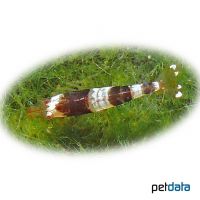New Bee Shrimp (Caridina venusta)
| New Bee Shrimp Caridina venusta | |
|---|---|
| Name | New Bee Shrimp |
| Name Lat. | Caridina venusta |
| Family | Shrimps |
| Family lat. | Atyidae |
| Order | Decapoda |
| Order lat. | Decapoda |
| Origin | Southern Asia |
| Habitat | Streams, ponds |
| Diet | Omnivore |
| pH | 5.5-7.0 |
| Behavior | Peaceful |
| Keeping | Group |
| Care Level | Easy |
| Reproduction | Oviparous |
| Breeding | Simple |
| Life Span | 1-2 years |
| Protection | No |
| Metric Units | |
| Size | 1.5-2.0 cm |
| Temperature | 15-25 °C |
| Hardness | 3-10 °dH |
| Aquarium | 20 l |
| US Units | |
| Size | 0.6"-0.8" |
| Temperature | 59-77 °F |
| Hardness | 53-178 ppm |
| Aquarium | 5 gal |
Distribution and habitat
The natural range of the bumblebee shrimp is in southern China in Guangdong Province, in the Yangde area. They live in stagnant or slow-flowing waters, such as ponds, lakes, streams and rivers.
Maintenance
They require a partially densely planted aquarium with many roots and a weak current. The substrate of dark sand or gravel should be partially covered with foliage (e.g. sea almond leaves, oak leaves), rotting plant material and mulm.
No ammonia, ammonium and nitrite should be detectable in the aquarium water, the nitrate value should not exceed 100 mg/l. To ensure the water quality and oxygen content, a filter and heater adapted to the size of the aquarium is required, as well as lighting for the species-appropriate day-night rhythm of the animals. When choosing the filter, special care should be taken to ensure that the animals cannot be sucked in.
Diet
In nature, they use the bristles of their scissor legs to rasp off growth organisms from stones, dead wood and plants
They can be fed well with autumn leaves of native trees (e.g. oak, beech, maple, birch), sea almond tree leaves as well as fresh, scalded nettle or dandelion leaves, spirulina algae and special shrimp food with low protein content (below 30%), plus spinach, freshly scalded or frozen. It is recommended to coat stones or roots with a slurry of spirulina, chlorella and other algae powder and place them in the aquarium after they have dried. Dry food for fish and crayfish, frozen or freeze-dried food as well as live food such as cyclops, daphnia, Artemia nauplii and microworms should only be offered occasionally due to the high protein content.
It is sufficient to feed them about 3 times a week. Unaccepted food should be siphoned off after about 12 hours. Regular and varied feeding promotes the well-being of the animals.
Behaviour and compatibility
They should be kept in a group of at least 10 animals. Keeping them in a species tank is recommended, but they can also be kept with small peaceful fish in a community tank with lots of moss and fine-leaved plants (hiding places). Socialization with other species of the serrata group (bee shrimp, tiger shrimp, etc.) is not recommended, as the animals will crossbreed. Basically, only compatible animals with similar requirements to the water condition and water temperature may be socialized.
Reproduction and breeding
The females are larger and more plump than the males
Breeding is relatively easy. After a molt of the female, the male attaches his sperm packet to the first swimming legs (pleopods) of the female. Then he pushes the eggs over these packages and fixes them to the pleopods. There the young develop to the last larval stage and are released with fully formed walking legs and scissor tufts.
Important
The foliage (sea almond, oak, beech, etc.) not only provides cover, but as it rots, it encourages the development of microorganisms that provide a valuable secondary food source
The well-being of the animals should be monitored regularly. Temperature should be checked daily, pH, hardness and nitrate levels at least every 14 days. Regular partial water changes are recommended, even when contaminant levels have not yet reached the upper limit. Sudden changes in water quality should be avoided. Newly introduced animals must be accustomed slowly to the water in the aquarium
Further literature can be found in your pet store.
References
Text: petdata; Image: petdata
Source: LUKHAUP & PEKNY (2008): Süßwasserkrebse aus aller Welt, Dähne Verlag; ENGELMANN & LANGE (2011): Zootierhaltung - Tiere in menschlicher Obhut: Wirbellose, Verlag Harri Deutsch
